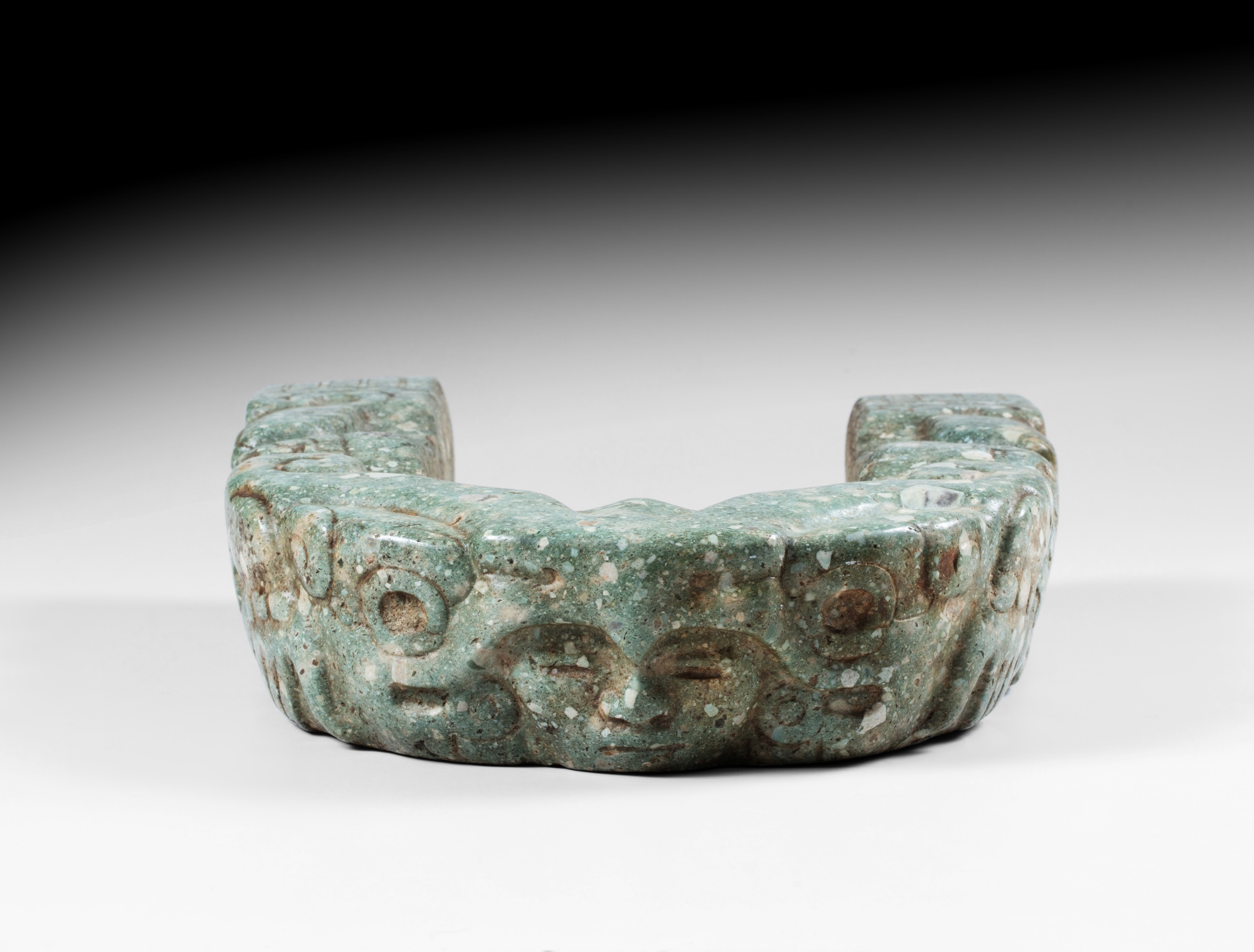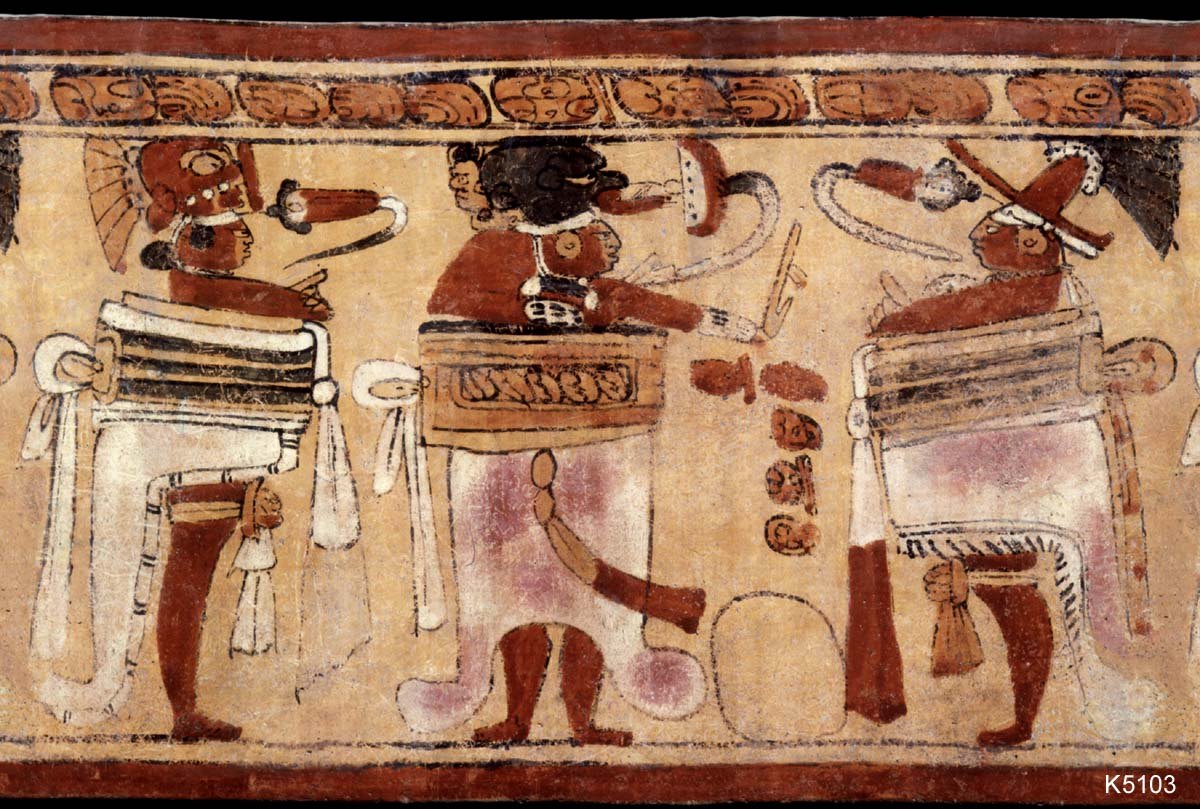24
Joug, Veracruz, ca. 650 - 950 ap. J-C. | Veracruz Stone Yoke, ca. AD 650 - 950
Provenant d'une collection privée européenne
Joug, Veracruz, ca. 650 - 950 ap. J-C.
Haut. 41,3 cm
________________________________________
Veracruz Stone Yoke, ca. AD 650 - 950
Height 16 ¼ in
>
Roland de Montaigu (1925-1990), Paris / New York, acquis vers 1960-1970
Sotheby's, New York, 24 novembre 1997, lot 137
Collection privée européenne, acquis lors de cette vente
Transmis par descendance
Catalogue note
Joug sculptué en profondeur dans un porphyre moucheté vert vif et blanc, et comportant la représentation d'une figure humaine montrée dans une posture cérémonielle, en position accroupie caractéristique d'un rituel de transformation et qui rappelle le dieu plongeur maya (Fig. 1) aux jambes et aux bras nettement repliés sur le côté, au visage idéalisé émergeant sous la coiffe d'un félin hargneux avec des motifs de plumes sculptés le long des côtés ondulés orné à chaque angle d'un visage humain idéalisé.
Le jeu de balle était l'un des rituels les plus populaires de l'ancienne Mésoamérique et son origine remonte probablement à la période olmèque, vers 1200 avant J.-C., dans la région du Golfe du Mexique. Le jeu était encore pratiqué par les Aztèques, comme l'ont rapporté les Espagnols dans leurs chroniques. Plus de 1500 terrains de jeu de balle ont été identifiés à ce jour. Il s'agissait à la fois d'un sport récréatif et d'une activité rituelle associée à la guerre, aux sacrifices et aux cycles du temps. La version maya du jeu se jouait sur des terrains construits en dur (fig.2).
Le joug est probablement la représentation cérémonielle d'un modèle plus léger (fig. 3), peut-être en cuir, qui était porté par les joueurs de jeu de balle mésoaméricains pour protéger leurs hanches lorsque la lourde balle en caoutchouc ricochait sur les murs de l'aire de jeu.
________________________________________
Deeply carved in speckled bright green and white porphyry with a human figure in a ceremonial posture as if crouching in a transformation ritual, reminiscent of the Mayan Diving God (Fig. 1), with legs and arms deeply bent tightly to the sides, the idealized face emerging beneath the snarling feline headdress, feather motifs carved along the undulating sides and each corner carved with an idealized human face.
The ballgame was one of the most popular rituals in ancient Mesoamerica, probably originating in the Olmec period, ca 1200 B.C., in the Gulf region of Mexico. The game was still played by the Aztecs as chronicled by the Spaniards. Over 1500 ball courts have been identified. .It was both a
recreational sport and a sacrosanct ritual activity associated with warfare, sacrifice and the cycles of time. The Maya version of the game was played in masonry courts (fig. 2).
The yoke is a likely a ceremonial representation of a lighter protective guard (fig. 3), possibly of leather, worn by Mesoamerican ballgame players to protect their hips as a heavy rubber ball ricocheted from the walls of the ball court during the fast-paced game.
(Fig. 1) K5103 © mayavasedatabase.com Photograph by Justin Kerr
(Fig. 2) Mayan ruins at Chichen Itza, Tinum municipality, Yucatan State, Mexico. Great Ball court ©
https://www.alamy.com
(Fig.3) 6242a © mayavasedatabase.com Photograph by Justin Kerr
Additional Notices & Disclaimers
L’exportation de ce bien hors de France (y compris vers d’autres pays de l’Union Européenne), ainsi que son exportation hors de l’Union Européenne, peuvent-être subordonnées à l’obtention d’une ou plusieurs autorisation(s) d’exporter ou d’importer. Sotheby’s, sur demande et contre paiement de frais administratifs, peut présenter une demande d’autorisation pour exporter votre(vos) Lot(s) hors de France.
The export of this property from France (including to other Member States of the European Union), as well as export from the European Union, may be subject to one or more export or import licenses being granted. Sotheby’s, upon request and for an administrative fee, may apply for a license to export your Lot(s) outside France.
Provenant d'une collection privée européenne
Joug, Veracruz, ca. 650 - 950 ap. J-C.
Haut. 41,3 cm
________________________________________
Veracruz Stone Yoke, ca. AD 650 - 950
Height 16 ¼ in
>
Roland de Montaigu (1925-1990), Paris / New York, acquis vers 1960-1970
Sotheby's, New York, 24 novembre 1997, lot 137
Collection privée européenne, acquis lors de cette vente
Transmis par descendance
Catalogue note
Joug sculptué en profondeur dans un porphyre moucheté vert vif et blanc, et comportant la représentation d'une figure humaine montrée dans une posture cérémonielle, en position accroupie caractéristique d'un rituel de transformation et qui rappelle le dieu plongeur maya (Fig. 1) aux jambes et aux bras nettement repliés sur le côté, au visage idéalisé émergeant sous la coiffe d'un félin hargneux avec des motifs de plumes sculptés le long des côtés ondulés orné à chaque angle d'un visage humain idéalisé.
Le jeu de balle était l'un des rituels les plus populaires de l'ancienne Mésoamérique et son origine remonte probablement à la période olmèque, vers 1200 avant J.-C., dans la région du Golfe du Mexique. Le jeu était encore pratiqué par les Aztèques, comme l'ont rapporté les Espagnols dans leurs chroniques. Plus de 1500 terrains de jeu de balle ont été identifiés à ce jour. Il s'agissait à la fois d'un sport récréatif et d'une activité rituelle associée à la guerre, aux sacrifices et aux cycles du temps. La version maya du jeu se jouait sur des terrains construits en dur (fig.2).
Le joug est probablement la représentation cérémonielle d'un modèle plus léger (fig. 3), peut-être en cuir, qui était porté par les joueurs de jeu de balle mésoaméricains pour protéger leurs hanches lorsque la lourde balle en caoutchouc ricochait sur les murs de l'aire de jeu.
________________________________________
Deeply carved in speckled bright green and white porphyry with a human figure in a ceremonial posture as if crouching in a transformation ritual, reminiscent of the Mayan Diving God (Fig. 1), with legs and arms deeply bent tightly to the sides, the idealized face emerging beneath the snarling feline headdress, feather motifs carved along the undulating sides and each corner carved with an idealized human face.
The ballgame was one of the most popular rituals in ancient Mesoamerica, probably originating in the Olmec period, ca 1200 B.C., in the Gulf region of Mexico. The game was still played by the Aztecs as chronicled by the Spaniards. Over 1500 ball courts have been identified. .It was both a
recreational sport and a sacrosanct ritual activity associated with warfare, sacrifice and the cycles of time. The Maya version of the game was played in masonry courts (fig. 2).
The yoke is a likely a ceremonial representation of a lighter protective guard (fig. 3), possibly of leather, worn by Mesoamerican ballgame players to protect their hips as a heavy rubber ball ricocheted from the walls of the ball court during the fast-paced game.
(Fig. 1) K5103 © mayavasedatabase.com Photograph by Justin Kerr
(Fig. 2) Mayan ruins at Chichen Itza, Tinum municipality, Yucatan State, Mexico. Great Ball court ©
https://www.alamy.com
(Fig.3) 6242a © mayavasedatabase.com Photograph by Justin Kerr
Additional Notices & Disclaimers
L’exportation de ce bien hors de France (y compris vers d’autres pays de l’Union Européenne), ainsi que son exportation hors de l’Union Européenne, peuvent-être subordonnées à l’obtention d’une ou plusieurs autorisation(s) d’exporter ou d’importer. Sotheby’s, sur demande et contre paiement de frais administratifs, peut présenter une demande d’autorisation pour exporter votre(vos) Lot(s) hors de France.
The export of this property from France (including to other Member States of the European Union), as well as export from the European Union, may be subject to one or more export or import licenses being granted. Sotheby’s, upon request and for an administrative fee, may apply for a license to export your Lot(s) outside France.
Art d'Afrique, d'Océanie, d'Indonésie et des Amériques
Sale Date(s)
Venue Address
General delivery information available from the auctioneer
Sotheby’s Post Sale Service teams can arrange expert delivery and convenient shipping of your property. We offer exceptional service and competitive rates whether shipping a diamond bracelet or a large piece of furniture. Fully knowledgeable on all international regulations, Sotheby's will compile a full range of services for you, including collection, packing and arranging for shipping and transit insurance worldwide. For sales in London and New York, simply provide us with your delivery address when you register for a sale. Following your purchase, we will send you a competitive and comprehensive shipping quote. For property purchased in all other salerooms, contact that office directly to arrange for the transport of your purchases.
To learn more, or if we may be of assistance contact us.
Important Information
https://www.sothebys.com/en/docs/pdf/conditions-of-business-for-buyers-london-27.09.23.pdf?locale=en
Terms & Conditions
https://www.sothebys.com/en/docs/pdf/conditions-of-business-for-buyers-london-27.09.23.pdf?locale=en





















